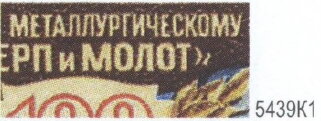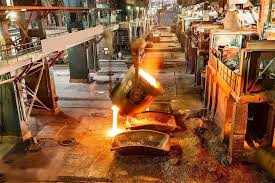Stamp: Centenary of the "Hammer & Sickle" Steel Mill, Moscow (Soviet Union, USSR 1983)
Centenary of the "Hammer & Sickle" Steel Mill, Moscow (Soviet Union, USSR 1983)
01 October (Soviet Union, USSR ) within release Centenary of the "Hammer & Sickle" Steel Mill, Moscow goes into circulation Stamp Centenary of the "Hammer & Sickle" Steel Mill, Moscow face value 4 Russian kopek
| Stamp Centenary of the "Hammer & Sickle" Steel Mill, Moscow in catalogues | |
|---|---|
| Michel: | Mi: SU 5319III |
| Soloviev: | Sol: SU 5439K1 |
Stamp is horizontal format.
Plate error: Quotation marks after МОЛОТ damaged (pos. 11).Also in the issue Centenary of the "Hammer & Sickle" Steel Mill, Moscow:
- Stamp - Centenary of the "Hammer & Sickle" Steel Mill, Moscow face value 4;
- Stamp - Centenary of the "Hammer & Sickle" Steel Mill, Moscow face value 4;
Stamp Centenary of the "Hammer & Sickle" Steel Mill, Moscow it reflects the thematic directions:
An anniversary is the date on which an event took place or an institution was founded in a previous year, and may also refer to the commemoration or celebration of that event. For example, the first event is the initial occurrence or, if planned, the inaugural of the event. One year later would be the first anniversary of that event. The word was first used for Catholic feasts to commemorate saints. Most countries celebrate national anniversaries, typically called national days. These could be the date of independence of the nation or the adoption of a new constitution or form of government. The important dates in a sitting monarch's reign may also be commemorated, an event often referred to as a "Jubilee".
A building or edifice is a structure with a roof and walls standing more or less permanently in one place, such as a house or factory. Buildings come in a variety of sizes, shapes and functions, and have been adapted throughout history for a wide number of factors, from building materials available, to weather conditions, to land prices, ground conditions, specific uses and aesthetic reasons. Buildings serve several needs of society – primarily as shelter from weather, security, living space, privacy, to store belongings, and to comfortably live and work. A building as a shelter represents a physical division of the human habitat (a place of comfort and safety) and the outside (a place that at times may be harsh and harmful).
A factory, manufacturing plant or a production plant is an industrial facility, often a complex consisting of several buildings filled with machinery, where workers manufacture items or operate machines which process each item into another. They are a critical part of modern economic production, with the majority of the world's goods being created or processed within factories.
A flag is a piece of fabric (most often rectangular or quadrilateral) with a distinctive design that is used as a symbol, as a signaling device, or as decoration. The term flag is also used to refer to the graphic design employed, and flags have since evolved into a general tool for rudimentary signalling and identification, especially in environments where communication is similarly challenging (such as the maritime environment where semaphore is used). National flags are patriotic symbols with varied wide-ranging interpretations, often including strong military associations due to their original and ongoing military uses. Flags are also used in messaging, advertising, or for other decorative purposes. The study of flags is known as vexillology, from the Latin word vexillum, meaning flag or banner.
In microeconomics, an industry is a branch of an economy that produces a closely related set of raw materials, goods, or services.For example, one might refer to the wood industry or to the insurance industry.
Metallurgy encompasses both the science and the technology of metals, including the production of metals and the engineering of metal components used in products for both consumers and manufacturers. Metallurgy is distinct from the craft of metalworking. Metalworking relies on metallurgy in a similar manner to how medicine relies on medical science for technical advancement. A specialist practitioner of metallurgy is known as a metallurgist.





